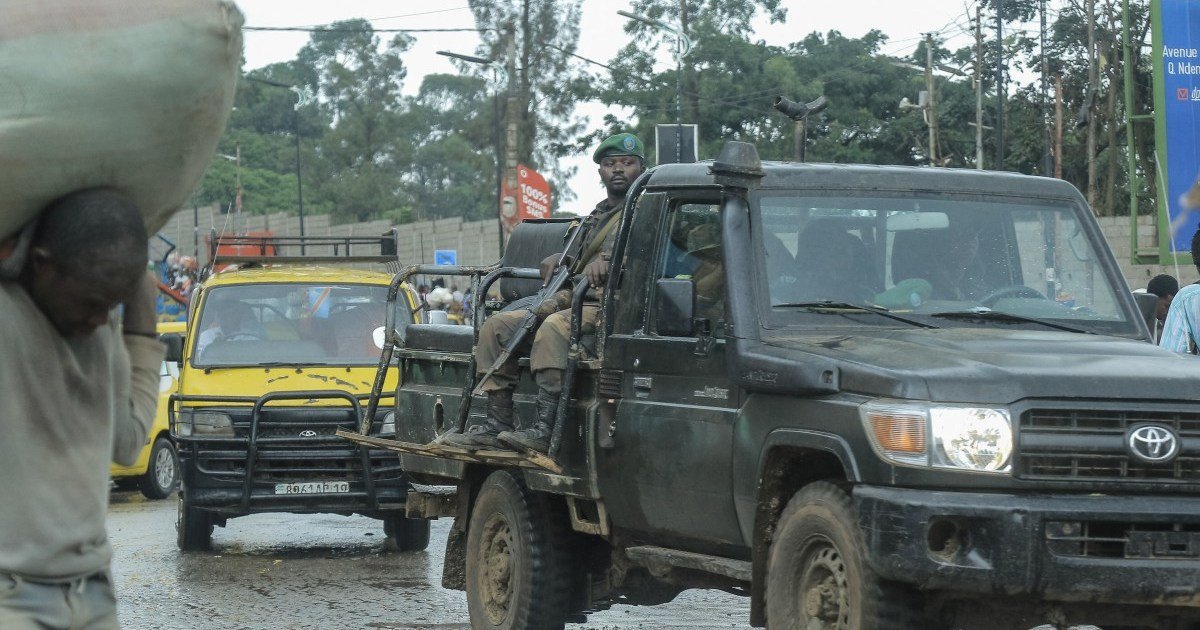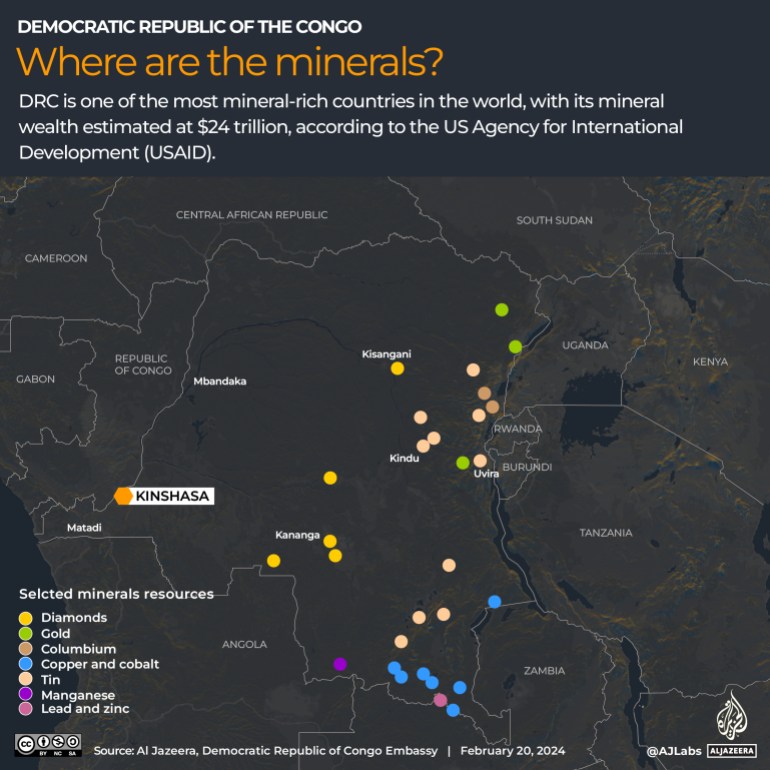Conflict Zones
Amid conflict, why does the DRC want a minerals deal with Trump? | Armed Groups News

The Democratic Republic of the Congo (DRC) is having “daily exchanges” with the United States government with the aim of securing a minerals-for-security deal, Congolese officials have told the media.
The move comes amid escalating violence in the East African country. The rebel M23 armed group has seized territory in areas rich in gold and coltan, an important mineral used in the manufacturing of electronic gadgets.
At least 7,000 people have been killed since January, according to the DRC government. Thousands more have been displaced.
Although there are no details of an official proposal for a deal with the US, DRC legislators appear to be hoping that the US will deploy troops to help contain the conflict in exchange for rights to the minerals. Analysts, however, say it is unclear whether such an alliance would align with US President Donald Trump’s “America First” policy, and that Washington would be more likely to take a less hands-on approach under any deal.
“The most likely scenario of such an agreement would be the US’s provision of military equipment to the DRC as opposed to any direct troop support,” Daniel van Dalen, senior analyst at South Africa-based security intelligence firm, Signal Risk, told Al Jazeera.
Here’s what we know so far about the DRC’s proposal:

Why is DRC seeking a minerals deal with the US now?
Observers say the DRC has been inspired by Washington’s proposal to support Ukraine in its war against Russia in exchange for a minerals deal.
That proposal entails Kyiv handing over a 50 percent stake in the country’s minerals revenue to enjoy a “long-term financial commitment to the development of a stable and economically prosperous Ukraine” from the US.
According to the Reuters news agency, Andre Wameso, deputy chief of staff to DRC’s President Felix Tshisekedi, went to Washington earlier this month to discuss a similar potential “partnership” with US officials. DRC officials have not disclosed specific details on what such a deal would entail.
Like Ukraine, the DRC needs security partners to win its war against the M23 and more than 100 other armed groups that have control of lucrative mines throughout the country. The resource-rich country is a major producer of tin, tungsten, tantalum and gold. These minerals, known collectively as 3TG, are used in the production of electronics, defence equipment, electric vehicles and other technology. DRC’s untapped natural resources are estimated to be worth some $24 trillion.

What has been proposed by Congolese legislators?
On February 21, the Africa Business Council, an international advocacy group for African business interests, wrote to US Secretary of State Marco Rubio, inviting the US to invest in DRC’s untapped resources. The group said it was acting on behalf of Congolese senator Pierre Kanda Kalambayi who chairs the DRC’s senate committee on defence, security and border protection.
The group suggested access to such investment could be made in exchange for “a long-term economic and security partnership that benefits both nations”.
In its proposal, the Africa Business Council proposed:
Access to DRC’s mines for US defence and technology companies and access to a port for exports.
Control of a joint mineral stockpile of Congolese minerals to be shared by the two countries.
In exchange, the US would provide training and equipment for Congolese forces and direct access to the US military in DRC.
US officials last week signalled a readiness to consider such proposals, but did not respond directly.
“The United States is open to discussing partnerships in this sector that are aligned with the Trump Administration’s America First Agenda,” a US State Department spokesperson told Reuters, noting that Congo held “a significant share of the world’s critical minerals required for advanced technologies”.
The spokesperson added that the US would want to boost private sector investment in the DRC “in a responsible and transparent manner”.
What is the armed conflict in DRC about?
A protracted conflict has raged in the DRC for more than 30 years. The country’s armed forces are weak as a result of government corruption, according to analysts. The country has endured two civil wars between 1996 and 2002, as well as the current rebellion of the M23, with many thousands killed. Millions of people have been displaced.
Defeating the M23 armed group is President Felix Tshisekedi’s top priority. Although several peacekeeping forces are currently in the country, including a United Nations mission (MONUSCO), M23 has managed to seize at least two major towns – Goma and Bukavu – in a lightning advance. It is presently closing in on a third – Walikale, a major mining hub.
A dispute with neighbouring Rwanda adds a further dimension to the conflict. The UN and US have both separately accused Rwanda of backing the M23 and supplying it with troops. They also allege the M23 group is smuggling gold, coltan and other minerals out of the DRC.
Rwanda’s President Paul Kagame denies any involvement with M23 but has in the past justified sending Rwandan soldiers to the DRC to protect Congolese Tutsis from alleged discrimination. That minority population fled Rwanda in 1994 in the wake of a genocide carried out by members of the Hutu majority.
Rwanda has also accused DRC of harbouring Hutu armed groups involved in the genocide. During the Congolese civil wars, UN reports concluded that both Rwanda and its ally, Uganda, had looted the DRC’s mineral resources.
Analysts fear that scenario is playing out again, this time via the M23’s control of lucrative mines in eastern DRC. The European Union, which signed a deal with Rwanda to supply 3TG minerals in February 2024, is now considering cancelling that contract. Rwanda currently supplies about 30 percent of the world’s tantalum. The EU has similar agreements with the DRC.
Several European countries, and the US, have in recent weeks imposed sanctions on key Rwandan officials they say are linked to the current violence in eastern DRC, and have called on Kagame’s government to withdraw troops.

How would the US benefit from a deal with DRC?
Analysts say Washington could benefit from direct access to DRC-government-owned minerals.
Former DRC President Joseph Kabila negotiated several minerals-for-infrastructure deals with China, although those have been criticised for not being transparent and for failing to deliver what was promised. Currently, Chinese companies dominate the investment landscape in DRC’s minerals industry. Nine of the biggest cobalt mining regions are in the DRC’s southern Katanga. Of the mines in those regions, half are run by Chinese operators.
Under President Tshisekedi, the DRC government appears ready to shift away from China and invite other players to own and operate mines. DRC has signed deals with the EU and India in the past two years. This week, DRC spokesperson Patrick Muyaya told Reuters the country was ready to “diversify” and that the US, in particular, would be welcome.
“If today American investors are interested in coming to the DRC, obviously they will find space … DRC has reserves that are available and it would also be good if American capital could invest here,” he said.
However, analyst van Dalen said it is unlikely that the US would seek to own mines in the DRC, as Congolese politicians have proposed, because this would mean Washington would “only be playing catch-up” with China.
“I don’t foresee a scenario where any agreement materially alters the domestic security landscape in the near term or China’s dominance in the sector,” he said.
A more likely scenario, he added, would see the US buying directly from the government, while its rival, China, continues to operate mines. That approach would also prevent any potential US-China “face-offs” on the ground.
What will happen next?
The two countries were already fostering a growing relationship under former President Joe Biden’s administration but it’s unclear if or when the DRC and the US would sign any deals.
Although there are no US companies operating in the country, the US is investing in the Lobito Corridor, an infrastructure project which includes the building of railways and ports to export DRC’s minerals through neighbouring Angola.
Under Trump, that relationship is set to become more transactional, analysts say, as the Ukraine negotiations have demonstrated.
However, experts also say it remains unclear how new US military equipment for the DRC would immediately change the course of the ongoing war, as the M23 continues its advance towards Kinshasa.
Such support would more likely bolster the DRC’s efforts to reform its weak military in the medium to long term, experts say.
